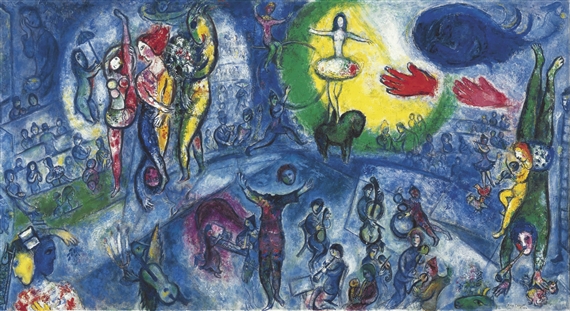The largest painting by Marc Chagall ever bought in Germany can be found in Frankfurt. And that’s not all: The piece is also the first Chagall created for a German client after 1945. Now, one could assume that due to its enormous size of 2.50 x 4 meters alone and the context of its creation, such an important work would be kept in the Städelmuseum or in another museum in Frankfurt. Yet this is not the case, as the painting entitled “Commedia dell’arte” is in the public domain – or, to be precise, in the so-called Chagall Hall of the Städtische Bühnen. The many Frankfurters who regularly visit the opera know the painting well – after all, introductory talks are often held there, and other events are also frequently staged in the Chagall Hall. The painting has been on display there since 1991 and is presented together with 14 reproductions of sketches by the artist.

The venturesome history of the “Commedia dell’arte”
Presumably, few actually know how the painting ended up in Frankfurt, and the history of the “Commedia dell’arte” is indeed one full of adventure. Originally the Frankfurt city councilor in charge of cultural affairs, Karl vom Rath, had wanted to acquire an already existing painting by Chagall for the main foyer of the Städtische Bühnen municipal theatre as it was being built. However, since the pieces he was interested in were no longer available, the artist suggested creating a painting especially for the Frankfurt location.
Chagall’s condition for creating the work was that he did not have to come to Frankfurt to produce the piece but that he would be able to work in Vence in southern France, where he lived at the time. This was of primary importance to Chagall, as after the end of World War II he had decided to never set foot on German soil ever again. Von Rath agreed to the proposal and now had to raise the money required for the acquisition. The city council assembly had agreed to the commission on the condition that the funds for the purchase money of 150,000 Deutschmarks be generated from private donations. Generous contributions by private individuals and Frankfurt companies together with the help of the Adolf und Luisa Haeuser-Stiftung, which now owns the painting, made it possible to raise the sum. The fourteen sketches, which are in part alternative compositions and in part preparatory studies, were bought later on. The work on the painting was not easy for Chagall. Due to its enormous size, the artist did not mount the canvas on a stretcher but nailed it straight onto the wall of his studio. In order to work on the upper sections, too, he used ladders or a small scaffold.


Not an “opera painting” in the traditional sense
Despite the painting having been created specifically for the context of the opera in Frankfurt, it is not really a true “opera painting”. The “Commedia dell’arte” shows a circus production and apart from the stage-like setting has nothing in common with the world of the opera. It is possible that the theme of the painting arose from Karl vom Rath’s original purchase requests. He had been interested, among others, in the painting “Le grand cirque”. The title of the work “Commedia dell’arte” was chosen by Chagall himself and poses a riddle. In Italian the term refers to the theatre of the 16th and 17th century, based on masked characters. However, this explanation does little for our better understanding of the work because Chagall’s interpretation of the title was much more inclusive, as he explained in conversation with Karl vom Rath: “It is not the case that I paint the world as ‘Commedia dell’arte’. The world is the ‘Commedia dell’arte’.”

Marc Chagall, Le grand cirque, 1956, Image via mutualart.com
Even though Chagall painted the piece entirely by his own hand and with great physical effort – he was, after all, already over 70 years old at the time – he was able to finish it within fourteen months on December 16, 1959. However, the theatre building in Frankfurt had not yet been completed at the time and the painting remained in Vence until the summer of 1960. After arriving in Frankfurt, it was first – and this seems barely conceivable today – deposited in its rolled-up state in a forwarding cellar near the main train station. Later on, the Städelmuseum served for its “interim storage”. It was only three years later, in December 1963, that “Commedia dell’arte” could finally be installed in the main foyer of the theatre building.

Yet the painting’s odyssey did not end there. There was a fire in the Städtische Bühnen building in 1987, and while the artwork was saved, it had now lost its previous place in the main foyer. As the renovation works went on until 1991, an alternative location needed to be found if the painting was not to be placed in storage for several years. A possibility arose with the main hall of Frankfurter Volksbank, where the painting could be viewed by the public free of charge during opening hours. In 1991 the “Commedia dell’arte” returned to the opera wing of the Städtische Bühnen. The painting, which journeyed from Vence in France, with detours to Frankfurt’s train station depot, to the Städelmuseum and other places, to then finally be placed in the Frankfurt opera’s Chagall Hall, can be viewed there on a visit to the opera.

